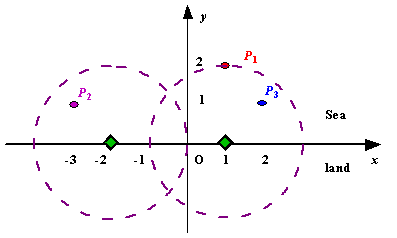Radar Installation
Time Limit:1000MS Memory Limit:10000KB 64bit IO Format:%I64d & %I64u
Description
Assume the coasting is an infinite straight line. Land is in one side of coasting, sea in the other. Each small island is a point locating in the sea side. And any radar installation, locating on the coasting, can only cover d
distance, so an island in the sea can be covered by a radius installation, if the distance between them is at most d.
We use Cartesian coordinate system, defining the coasting is the x-axis. The sea side is above x-axis, and the land side below. Given the position of each island in the sea, and given the distance of the coverage of the radar installation, your task is to write a program to find the minimal number of radar installations to cover all the islands. Note that the position of an island is represented by its x-y coordinates.

Figure A Sample Input of Radar Installations
We use Cartesian coordinate system, defining the coasting is the x-axis. The sea side is above x-axis, and the land side below. Given the position of each island in the sea, and given the distance of the coverage of the radar installation, your task is to write a program to find the minimal number of radar installations to cover all the islands. Note that the position of an island is represented by its x-y coordinates.

Figure A Sample Input of Radar Installations
Input
The input consists of several test cases. The first line of each case contains two integers n (1<=n<=1000) and d, where n is the number of islands in the sea and d is the distance of coverage of the radar installation. This is
followed by n lines each containing two integers representing the coordinate of the position of each island. Then a blank line follows to separate the cases.
The input is terminated by a line containing pair of zeros
The input is terminated by a line containing pair of zeros
Output
For each test case output one line consisting of the test case number followed by the minimal number of radar installations needed. "-1" installation means no solution for that case.
Sample Input
3 2 1 2 -3 1 2 1 1 2 0 2 0 0
Sample Output
Case 1: 2 Case 2: 1
题意:雷达区间覆盖。
算法:区间化+贪心
#include<iostream>
#include<algorithm>
#include<cmath>
#include<cstdio>
#define MAXN 10000
using namespace std;
struct node{
double l, r;
}Line[MAXN];
bool cmp(node a, node b)//根据结点左区间从小到大排序
{
return a.l<b.l;
}
int main()
{
int n;
double d;
int Numcase=0;
while(~scanf("%d%lf", &n, &d))//本来用cin输入,竟然TLE了
{
double x, y;
int cnt=1;
bool flag=false;//如果岛到x轴的距离大于d,那雷达肯定覆盖不了此岛,直接输出-1;
if(n==0&&d==0) break;
for(int i=0; i<n; i++)
{
cin>>x>>y;
if(fabs(y)>d) flag = true;
Line[i].l = x-sqrt(d*d-y*y);//以(x,y)为圆心,d为半径画圆,交x轴两点
Line[i].r = x+sqrt(d*d-y*y);//分别用 Line[i].l 和 Line[i].r 表示
}
if(flag) { cout<<"Case "<<++Numcase<<": "<<-1<<endl; continue; }
sort(Line, Line+n, cmp);//排序
double now;
now = Line[0].r;
for(int i=1; i<n; i++)
{
if(now > Line[i].r)//在所有右结点中,找到距原点最远的点作为now的初始值,开始贪心。
now = Line[i].r;
else if(now <Line[i].l)
{
now = Line[i].r;
cnt++;
}
}
cout<<"Case "<<++Numcase<<": "<<cnt<<endl;
}
return 0;
}
WA了好几次。。。。。







 解决海岸线上雷达站点设置问题,确保岛屿被雷达有效覆盖。通过区间化和贪心算法确定最少雷达数量。
解决海岸线上雷达站点设置问题,确保岛屿被雷达有效覆盖。通过区间化和贪心算法确定最少雷达数量。

















 1187
1187

 被折叠的 条评论
为什么被折叠?
被折叠的 条评论
为什么被折叠?








